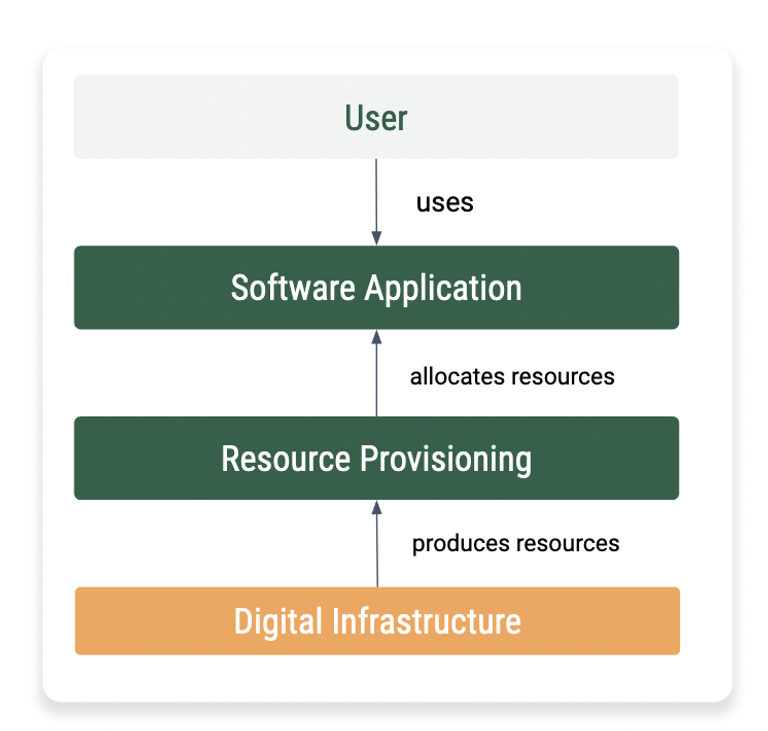Transparency
Transparency is a key value of Leitmotiv and this Wiki. The absence of reliable data on the environmental impact of digital products, and thus the digital economy, is hindering adequate action plans to reduce them. This limits the potential of the digital economy and hinders opportunities for digital sustainability and must be addressed urgently.
This page is work in progress.
Table of contents
- Goals of transparency
- Why only environmental impact
- A matter of scale
- A new School of Thought
- Responsibility
- Environmental Impact Indicators
Goals of transparency
- to have an understanding of negative impacts of digital sector and develop plans to mitigate them,
- to unlock the information required for scientific inquiry & fact-based policy-making,
- and to create a competitive advantage for digital products which are transparent about the environmental & social impacts of their business.
Why only environmental impact
There is already an absence of facts on the environmental impact of the digital sector as whole. However, there are existing environmental impact indicators and assessment methods from other sectors which be can applied to digital products as well such as the Life Cycle Assessment (link needed).
We strongly advocate for developing similar frameworks for social impact (such as Social Life Cycle Assessment, or S-LCA) because we feel the current frameworks are not mature and are complex to apply for the digital sector. See also Problems to solve.
A matter of scale
The digital economy consists of some very large, international digital product companies like YouTube, Instagram or Zalando. They are different in terms of scale than traditional enterprise IT tools or software utilized to digitalize business or government 1.
Both digital products & software should make the environmental impact of their usage transparent to the person or organization which is using it. The only distinction is that digital economy actors also should be transparent towards society as they are operating in the public sphere and have both environmental and social impacts of significant scale.
A new School of Thought
Our simplified school-of-thought is centered on the idea that there is a digital resource2, which has an environmental impact stemming from the energy & materials of the computers, buildings and infrastructure producing it.
The digital resource is allocated & consumed to provide a service (e.g. streaming 1 minute of video) and hence this usage can be attributed a ‘resource usage’ and associated environmental impact.

- User - any person, customer, organization utilizing a software application (which can be a digital product or an internal software application)
- A software application which is providing a service that consumes digital resources to operate for a customer.
- Examples: ERP System within an enterprise, ticket purchasing application for a concert, a social networking platform, a video streaming application
- Resource provisioning allocates the digital resources to the software applications.
- Examples: Cloud infrastructure providers, web hosting companies, virtualization software manufacturers
- Digital infrastructure is producing digital resources by employing computers, which are housed in data centers and connected through networks. All of which consume natural resources, metals, energy and other commodities.
Responsibility
In-line with our values, our model enables the allocation of responsibilities on transparency to the different actors – from the digital product itself to its supply chain:
- Digital infrastructure actors need to be transparent about how many digital resources are produced with the environmental impact per unit.
- Resource provisioning actors need to be transparent about how many resources could not be allocated & used (and hence are wasted), as well as pass-through the environmental impact per resource to the software application.
- Software applications need to transform the digital resource usage they create into environmental impact (using the information provided by the resource provisioning actors) and make it transparent to the user, creating transparency on the usage-based impact.
Examples
In our view, the following should be true if actors in the digital economy were transparent about their environmental impact.
- YouTube
- Towards the public, YouTube would have to report how many minutes of video are stored and the total environmental impact of those stored videos
- Towards the user, YouTube would have to report the environmental impact of a video minute stored, as well as the total impact of the user’s video minutes stored
- An SAP ERP
- If used within the company, it should not have to be transparent towards the public
- Towards the user, the ERP system should report the environmental impact of the total usage, e.g. the impact of performing a payroll or for generating a report and provide a historic overview & total balance of environmental impact created by the user
Environmental Impact Indicators
To report the environmental impact, we have selected the relevant environmental impact indicators from the Life Cycle Assessment Framework for buildings (EN15804 +A2) and applied them to digital resources. You can find them here (link needed).
See definitions for a better understanding of the differences between the various field of IT & digital. ↩
Learn more about our definition of a digital product. ↩
